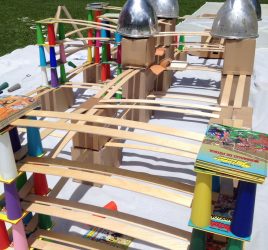Basurama: a framework for designing collectively with waste
This paper was presented to the Reclaim and Remake International Symposium, Washington, DC. 11-13 April 2013 by Pablo Rey Mazón. There is an audio and slide presentation available: Audio and slides.
«Architecture is the masterly, correct and magnificent play of masses brought together in light.»
Le Corbusier, 1923«Architecture is the correct management of materials, place, economic resources, time and people to achieve a useful space for the people.»
Le Corbusier Revisited, 2013
Abstract
Basurama (trash-o-rama) is a non profit organization based in Spain that has been experimenting with different approaches to waste over the last decade. It has developed a framework to create projects that provide a better understanding of waste as a resource, and raise awareness of waste production. These projects take shape in many different ways, such as workshops, public art interventions, maps or data visualizations, and work with a wide range of stakeholders, ranging from neighborhood communities and local artists to municipal governments.
Across all the different kinds of projects, participant-users take active part in the search, selection of waste, as well as in the collaborative process of design and construction. Through practice, participants become aware of the implications of using waste as a source material: properties, availability, and transportation. The process changes the way designers and communities approach the design project, and provides a better way to understand how to work with what already exists, be it abandoned public space or leftover materials.
Among many other activities, Basurama’s practice has been centered on workshops, that last 2-4 weeks, to plan, research, design and construct. In that short period of time, Basuramas’s team connects with local agents to understand their needs and develop a site specific project. Local materials and techniques are used to enable the appropriation of the project by local actors and allow its replication. The proliferation of industrial waste, like car tires or pallets, allows the reproduction of these techniques across countries and certain reuse methods have been developed.
Due to the limitations of a short intervention and, in order to understand and provide this experience to others, we thought it was a good idea to analyze in detail how this process was. As a Basurama member I felt the need to extend this kind of reuse practices beyond the scope of our own projects and to conceptualize the work that had been done. These projects work both as a prototype and a ‘hands on’ method to train locals to build their own environments. This paper is an analysis of the 2-4 week long workshops that Basurama has been developing abroad. It will use as a case study the group of interventions in Latin America from the RUS project, specially RUS Lima (Peru).
We have found that to achieve environmentally responsible processes that reuse materials, it is fundamental to take into account the limitations and locations of materials and the qualities and possibilities of the selected space. That would be a bottom line for almost all reuse projects. However, to design and construct collectively and allow the appropriation of the project by local agents (a community of users/citizens) they must also be included in the project since the beginning, as a fundamental variable for the long term success.
This paper establishes a foundation for a toolkit/guide for communities to be able to work collectively with their own waste, to transform their built environment, and create a better public space.


